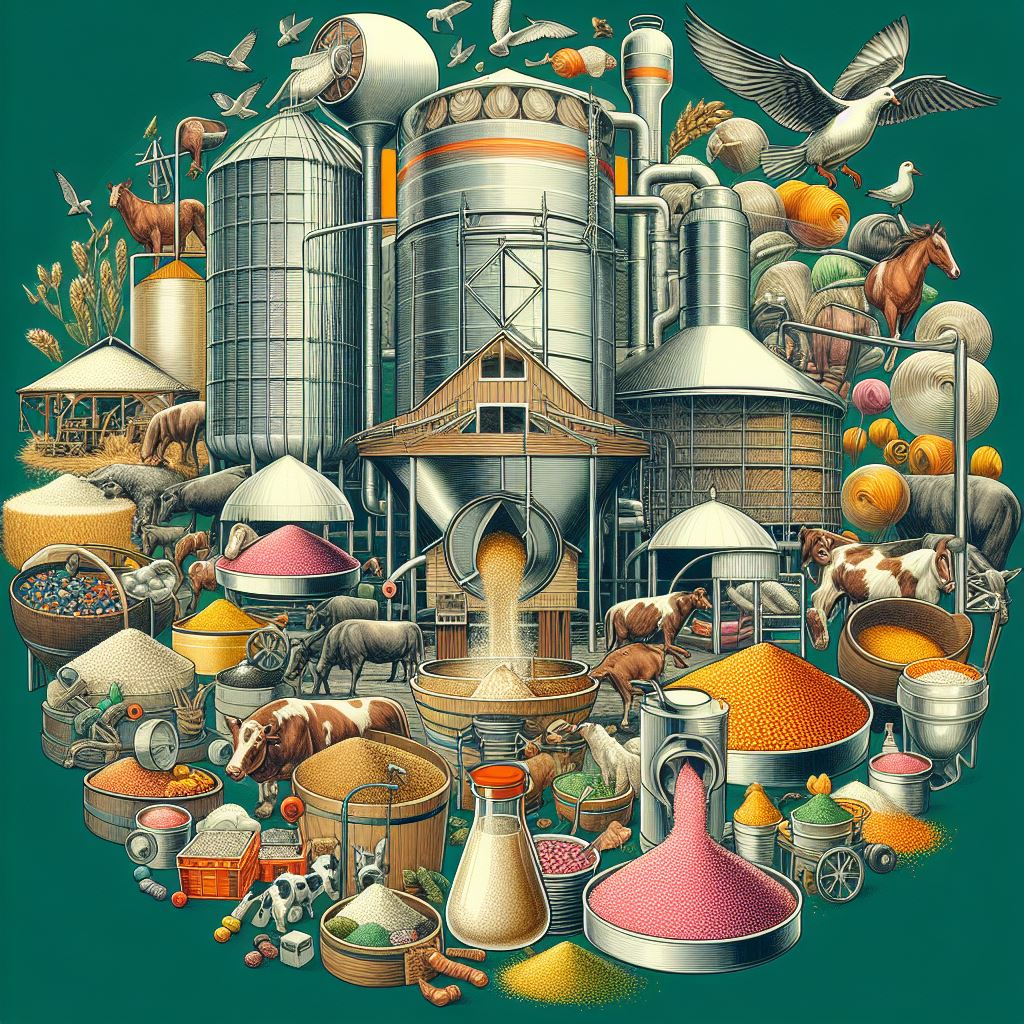
Feed formulation 2.jpg
Feed Formulation
Definition of Feed Formulation
Feed formulation is the process of quantitatively and qualitatively balancing feed ingredients to create a diet that meets the nutritional requirements of livestock. It aims to provide animals with the necessary nutrients for their growth, reproduction, health, and productivity at a minimal cost.
Key Components of Feed Formulation
Understanding Ingredient Profiles
Each ingredient in a feed mix has a profile of nutrients it offers, including proteins, fats, fibers, vitamins, and minerals. Understanding these profiles is crucial to creating a balanced diet that meets the specific needs of different animal species and age groups.
Fall off the barn roof and busted your keister? Life on the farm or ranch can be tough on the bum. Need a break? Laugh it off at FarmerCowboy.com, the #1 farm humor site. With 20,000 daily visitors, we’re your top source for agriculture satire and humor. Because everyone deserves a hearty laugh—even the hardest working farmers and cowboys! Join us and turn those long days into fun tales at FarmerCowboy.com.
Balancing Nutrients
Balancing nutrients involves ensuring that the ratios of different nutrients are appropriate for the animal’s stage in life and production goals. This includes calculating the correct proportions of energy to protein, minerals, and vitamins to prevent deficiencies or excesses, which can lead to health problems.
Practical Advice on Effective Feed Formulation
Use of Formulation Software
Many farms and feed mills use specialized software to aid in feed formulation. These programs help in calculating nutritional needs, ingredient ratios, and cost implications, making it easier to create efficient and cost-effective feed mixes.
Cost-Effectiveness
While nutritional adequacy is paramount, economic factors cannot be ignored. The choice of ingredients often depends on their availability and cost. Feed formulators need to balance cost with nutritional quality, considering local availability of resources to minimize expenses.
Continuous Evaluation and Adjustment
Feed formulas should not be static. Regular evaluation of animal health, growth rates, and production output is essential. These data help in adjusting feed formulas to better meet the evolving needs of the livestock and address any issues related to diet.
Advanced Techniques in Feed Formulation
Precision Nutrition
Advancements in technology have led to the development of precision nutrition techniques where individual animals are monitored, and their feed formulation is adjusted based on real-time data. This approach can significantly enhance efficiency by minimizing waste and improving health outcomes.
Alternative Ingredients
Research into alternative feed ingredients, such as by-products from other industries or novel proteins (like insects or algae), is expanding. These alternatives can reduce costs and the environmental impact of feed production.
Formulating for Health
Beyond meeting basic nutritional requirements, feed can be formulated to address specific health challenges. For example, adding certain fibers can improve gut health, while specific minerals and vitamins can enhance immune responses.
Conclusion
Feed formulation is a critical skill in animal husbandry that directly affects the health and productivity of livestock. By applying the latest research and technologies in this field, farmers and feed formulators can create diets that are both nutritious and cost-effective, thus enhancing the sustainability of their operations.
Feed Formulation: Helpful Information
Feed formulation is a complex yet essential process that directly impacts the health, growth, and productivity of livestock. By integrating practical advice, actionable suggestions, and beneficial guidance, this article aims to provide comprehensive support to farmers and feed formulators.
Practical Insights into Ingredient Selection and Management
Strategic Ingredient Sourcing
To enhance feed formulation, it is crucial to strategically source ingredients. This involves identifying suppliers who offer high-quality ingredients at competitive prices. Building strong relationships with local farmers and suppliers can also ensure a steady supply of fresh, cost-effective feed components.
Ingredient Storage and Quality Control
Proper storage and handling of feed ingredients are vital to maintaining their nutritional value. Implementing quality control measures such as regular sampling and analysis helps in detecting any issues related to pests, mold, or nutrient degradation, thereby ensuring that the feed remains effective and safe for consumption.
Cost-Effective Strategies in Feed Formulation
Bulk Purchasing and Seasonal Buying
One way to reduce costs is through bulk purchasing of ingredients when prices are lower. Seasonal buying, especially of locally available ingredients, can also capitalize on lower prices and fresher supplies, thereby reducing the overall cost of the feed mix.
Alternative and By-product Utilization
Incorporating by-products from other agricultural processes, such as rice bran, beet pulp, and used brewery grains, can provide cost-effective alternatives to traditional feed ingredients. These options not only lower costs but also contribute to environmental sustainability by reducing waste.
Leveraging Technology for Precision and Efficiency
Automated Feed Mixing and Dispensing
Advanced technology can automate the mixing and dispensing of feed, ensuring precise measurements and consistent quality. Automated systems reduce labor costs and minimize human error, leading to more accurate and efficient feed formulation.
Data Analytics for Optimized Formulation
Utilizing data analytics can transform feed management by providing insights into the effectiveness of different feed mixes. Analysis of growth rates, feed intake, and overall health metrics allows for fine-tuning of formulations to achieve optimal results.
Health-Oriented Feed Formulation
Customized Nutrient Profiles
Tailoring nutrient profiles to specific health conditions or stages of development can significantly improve the welfare and productivity of livestock. For instance, diets high in antioxidants can boost immune systems, while those rich in omega-3 fatty acids can improve reproductive health.
Probiotics and Prebiotics
Incorporating probiotics and prebiotics into feed can enhance gut health and digestion, leading to better nutrient absorption and reduced instances of gastrointestinal diseases. This not only improves animal welfare but also increases feed efficiency.
Conclusion
Effective feed formulation is integral to the success of livestock management. By applying practical advice, innovative techniques, and leveraging technology, farmers can create nutrient-rich, cost-effective diets tailored to the specific needs of their animals. This approach not only supports animal health and productivity but also promotes sustainability and profitability in livestock farming.
References
- Global Feed Science Institute: Offers in-depth discussions on the latest trends and technologies in feed formulation.
- National Livestock Nutrition Council: Provides essential information on the nutritional requirements of domesticated livestock.
- Journal of Sustainable Agriculture: Explores cost-effective and sustainable options in feed ingredients.
- “Advanced Feed Formulation Techniques,” a publication by the Global Feed Science Institute, which offers in-depth discussions on the latest trends and technologies in feed formulation.
- “Nutritional Requirements of Domesticated Livestock,” a manual from the National Livestock Nutrition Council. This resource is fundamental in understanding the diverse nutritional needs of different livestock.
- “The Use of Alternative Feed Ingredients in Animal Nutrition,” a research article from the Journal of Sustainable Agriculture. It explores cost-effective and sustainable options in feed ingredients.
Originally posted 2020-02-21 03:34:07.
Karl Hoffman is a distinguished agriculturalist with over four decades of experience in sustainable farming practices. He holds a Ph.D. in Agronomy from Cornell University and has made significant contributions as a professor at Iowa State University. Hoffman’s groundbreaking research on integrated pest management and soil health has revolutionized modern agriculture. As a respected farm journalist, his column “Field Notes with Karl Hoffman” and his blog “The Modern Farmer” provide insightful, practical advice to a global audience. Hoffman’s work with the USDA and the United Nations FAO has enhanced food security worldwide. His awards include the USDA’s Distinguished Service Award and the World Food Prize, reflecting his profound impact on agriculture and sustainability.





To be enlightened is to be open to learning from every experience, every person, every day. ??